How to Store Strawberries 12 Ways
This post may contain affiliate links. Read my full disclosure here.
Perfectly ripe strawberries are yummy, but strawberries also top the “Dirty Dozen” list for highest amounts of pesticide residue. We’re lucky enough to have an organic strawberry farm nearby that uses no pesticides, so when strawberry season comes around, we stock up!
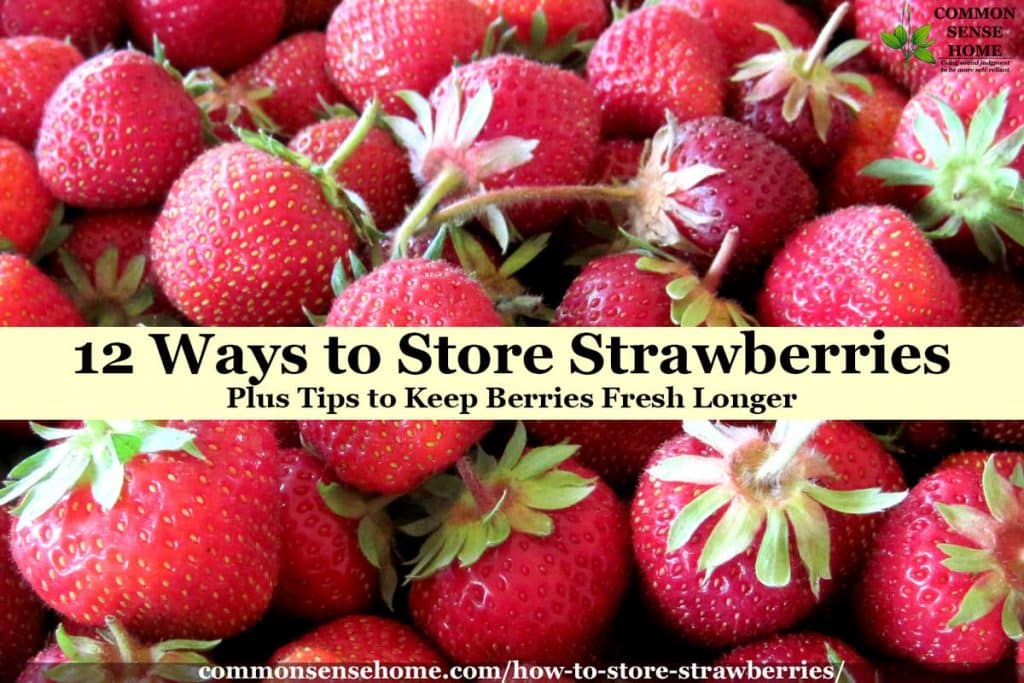
How to Store Strawberries for Fresh Eating or Year Round Use
In this post, I’ll share how to store strawberries 12 different ways, plus how to keep strawberries fresh. We cover freezing, dehydrating, homemade fruit leather, strawberry kombucha, freeze drying, strawberry jam (regular and low sugar), and strawberry wine and mead.
The Best Way to Store Fresh Strawberries – 4 Quick Tips
- Keep the stems on your strawberries! Once the stems are off, the berries start breaking down quickly.
- Don’t wash or soak strawberries until you’re ready to eat them. Water will make the berries mushy.
- Watch out for moldy strawberries. If you spot one going bad, compost it. One moldy berry can spoil a whole container.
- Hold off on cutting your strawberries if you want them to last longer.
If you’re eating the berries right away, they can stay on the counter top. If you’d like them to last a few days, store in the refrigerator. Once you cut your strawberries, the strawberry storage clock speeds up and they won’t keep as long. Seal cut strawberries in an airtight container and store in the refrigerator.
The boys and I go strawberry picking locally every year, just like I used to go with my momma. (The Little Mouse, The Red Ripe Strawberry, and The Big Hungry Bear used to be one of my oldest son’s favorite books when he was little.)
The strawberry season is short here – generally 2-3 weeks at most, depending on the weather, but we try to get out picking at least twice. For strawberry storage that we can enjoy year round, I use several different methods of preserving strawberries.
How to Freeze Strawberries
Frozen berries are great for smoothies or using in recipes where a soft or frozen berry is acceptable. The freeze/thaw process breaks down the cell walls, so these berries will be soft and juicy when thawed. Great for shortcake, but a little messy to eat as a finger food.
The best way to freeze strawberries is to start by gently rinsing the berries under running water in a colander. (I invested in an over the sink colander several years ago and I use it all the time for fruit and vegetables.)
I don’t recommend washing your berries in a basin of water. They will act like little sponges and soak up additional water, making them mushy and tasteless.
Place the washed berries on a couple of layers of old t-shirts or towels next to the sink to drip dry. Hull the strawberries and remove any damaged spots with a paring knife.
Can You Eat Strawberry Tops?
Yes, strawberry tops are safe to eat! If you know you will only be using your berries for smoothies or another application where they will be well blended, it’s fine to leave the tops on.
Not only are they edible, strawberry leaves are rich in vitamins and minerals plus ellagic acid, a highly touted cancer preventive.
Place strawberries on a sheet pan covered with reusable parchment paper or parchment paper. I typically load them into the freezer on trays one day and vacuum seal them the next.
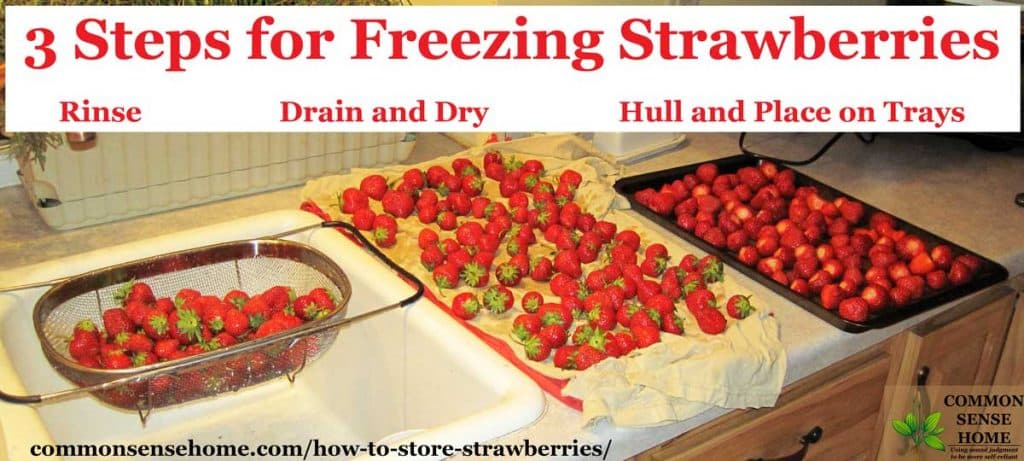
When vacuum sealing, make sure that you keep the opening of your bag completely clear of moisture to get a good seal.
Don’t try vacuum sealing unfrozen berries. As the sealer pulls air out of the bag, the berries will compress and juice will be squeezed out of your berries and into the vacuum sealer. You’ll make a really big mess and your bags may not seal.
Write the contents and date with a Sharpie marker somewhere on the bag, just in case they disappear into the bowels of the freezer and are uncovered much later.
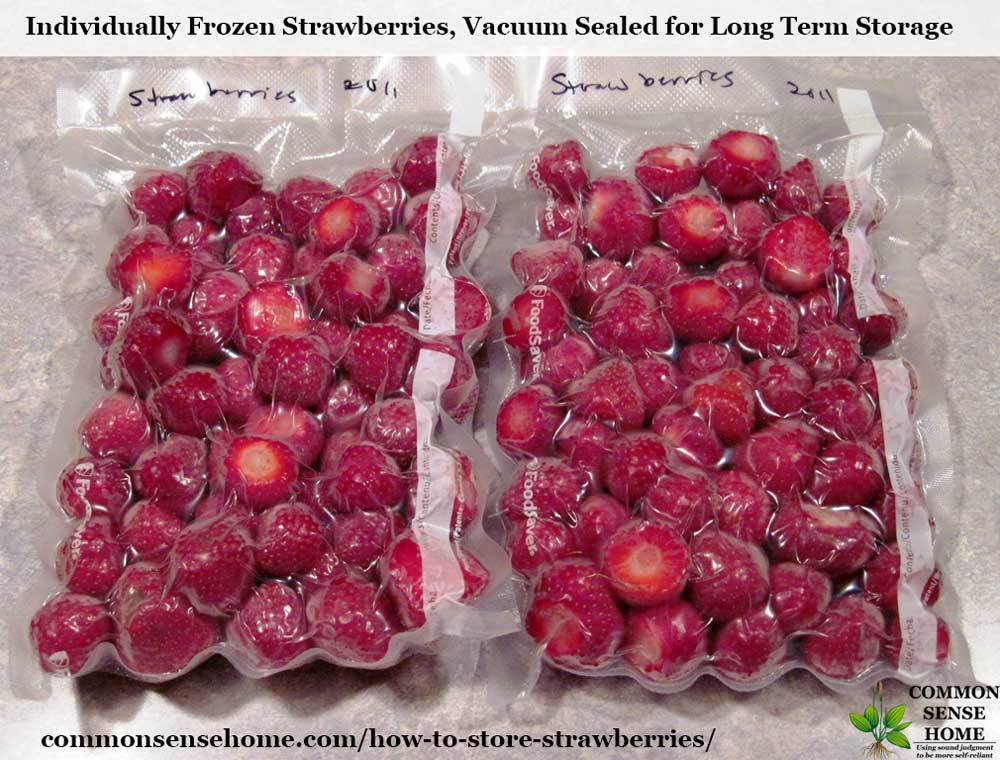
Do you have to vacuum seal frozen berries?
No, but I like the quality of the fruit much better when it’s vacuum sealed. Properly vacuum sealed, these berries will last well over a year with no appreciable ice crystal formation and very little visible deterioration. (I can easily store strawberries from one season to the next season.)
If you don’t have a vacuum sealer, you may want to crush the berries before packaging, as the juice will help protect the berries and prevent ice crystal formation. You could also layer the berries in a container with sugar, which will also help prevent ice crystal formation.
How to Dry (Dehydrate) Strawberries
Dried (Dehydrated) strawberries are great for snacking. They can also be used for cooking, as is or rehydrated.
For individually sliced and dried berries, clean berries as for freezing, then slice vertically to a uniform thickness (roughly 1/4 to 1/8 inch thick). Uniformly sized pieces will dry more evenly. No pre-treatment is necessary.
Load pieces on a dehydrator tray so that they are evenly spaced and not touching. (Clean-a-screen inserts will help to keep the dry fruit from falling through the trays.)
Dry at 135°F/58°C for around eight hours or overnight, until fruit is brittle and crisp and will break instead of bending. Strawberries are 91% water, so they will shrink up a lot!
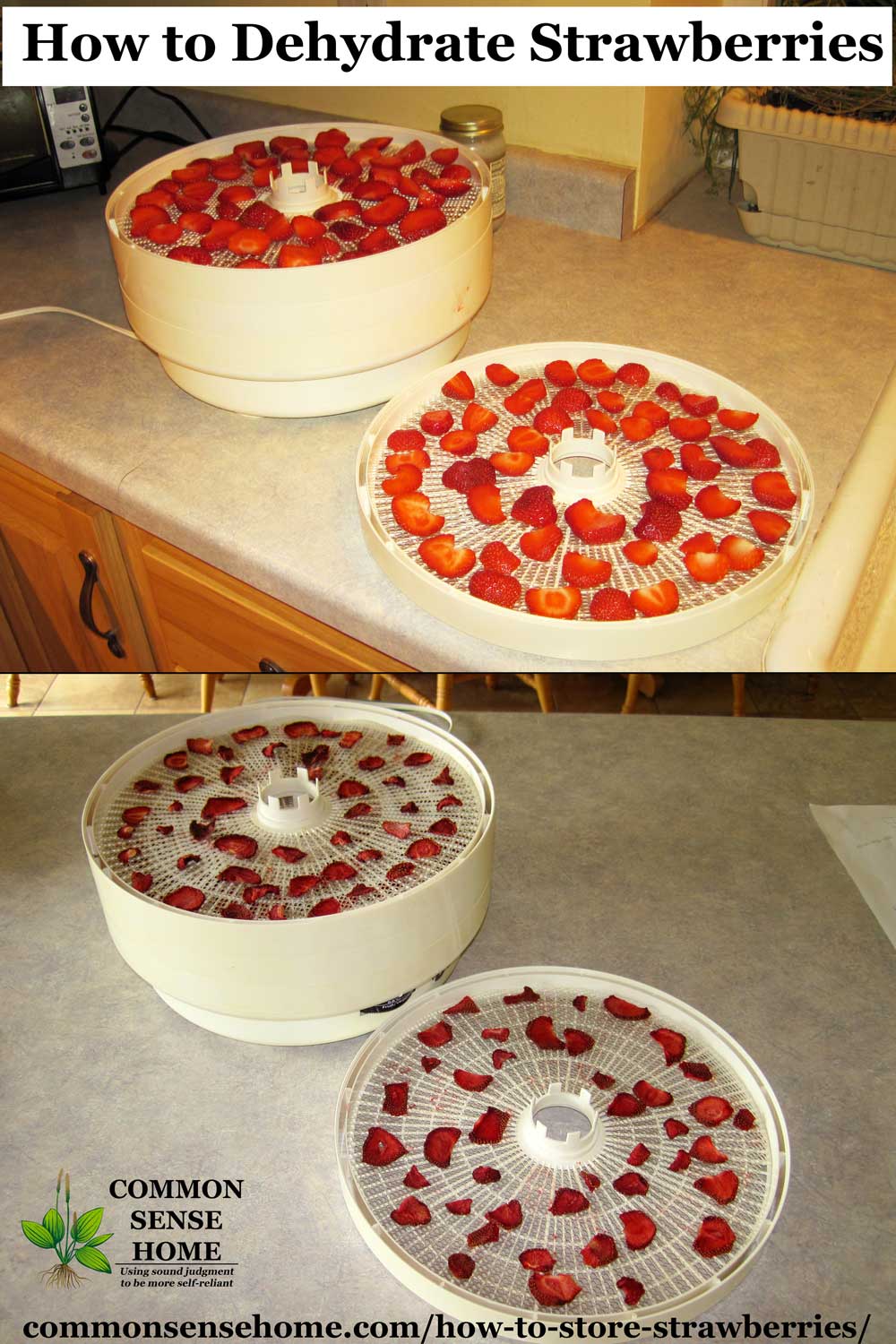
Remove dried strawberries from dehydrator trays and store in a tightly sealed container. For longest storage, vacuum seal in mason jars or seal in a Mylar pouch with oxygen absorbers.
Recommended food dehydrators:
- Snackmaster Pro Food Dehydrator
- Excalibur 9 Tray Food Dehydrator
- Magic Mill 6 Tray Dehydrator with Stainless Steel Drying Racks
How to Make Strawberry Fruit Leather
Strawberry fruit leather is another great snack option. The trick to a good “leather” is applesauce.
Strawberries are low in pectin, so a strawberry only fruit leather will be brittle instead of supple/more leathery.
To make strawberry fruit leather, puree fruits, tops and all, in a good quality blender such as a Vitamix. Measure your puree, and add an equal amount of applesauce.
Would you like to save this?
For instance, if you have two cups of strawberry puree, adds two cups of applesauce. Homemade applesauce is great if you have it. In my experience, it works a little better than commercial varieties.
Oil your fruit leather sheet with coconut oil to prevent sticking. Pour strawberry/applesauce puree on the sheet to a thickness of around 1/8 to 1/4 inch.
Thinner puree will result in a crisper end product, like a chip, thicker will give you a product more like fruit leather. Try to get it as even as possible so that it dries evenly.

Dehydrate at 135°F/58°C until dry and leathery, around 8 to 10 hours or overnight. Store in a sealed container.
For more tips on making homemade fruit roll ups, visit “Homemade Fruit Leather Recipe – Works with a Variety of Fruits“.

How to Make Strawberry Flavored Kombucha
Strawberry flavored kombucha couldn’t be simpler. Just add whole strawberries or strawberry puree to your finished kombucha when you bottle it after the initial brewing period. I add approximately 1/2 cup of fruit per quart, sometimes a bit more.
Strawberries are quite tart, even though they are high in sugar, so you may wish to use a younger brew (7-10 days) instead of an older brew, otherwise the finished product may be overly acidic.
If you are using a bail top bottle, please be aware that the high sugar content of the berries will make your kombucha very active and potentially cause high CO2 build up – beware exploding bottles!
Here’s a gorgeous glass of strawberry kombucha my friend, Tami, made recently. Doesn’t that look cool and refreshing for a hot summer day?

I’ve kept kombucha for several months in the refrigerator. The yeast and bacteria in the drink act as a natural preservative for the fruit. It just gets stronger and more fizzy over time.
How to Freeze Dry Strawberries for REALLY Long Term Strawberry Storage
In 2016, we invested in a Harvest Right home freeze dryer. Since we got it, we’ve dried everything from strawberries and bananas to fajitas. (You can read my review here.)
Almost anything can be freeze dried, and the flavor and texture of the finished product is excellent. With a shelf life of up to 25 years, freeze dried products add an extra layer of security to any food storage.
Unlike the leathery texture of dehydrated berries, freeze dried berries are light and crisp. (You may have had commercially freeze dried berries in cereals or as a snack.)
The freeze dried berries can also be pulverized in a high powered blender to make strawberry powder to add to desserts for color and flavor.
(Strawberry whipped cream? Yum!)
See “Dehydrator Versus Freeze Dryer – What’s the Difference” for a comparison of how the different methods and equipment work.
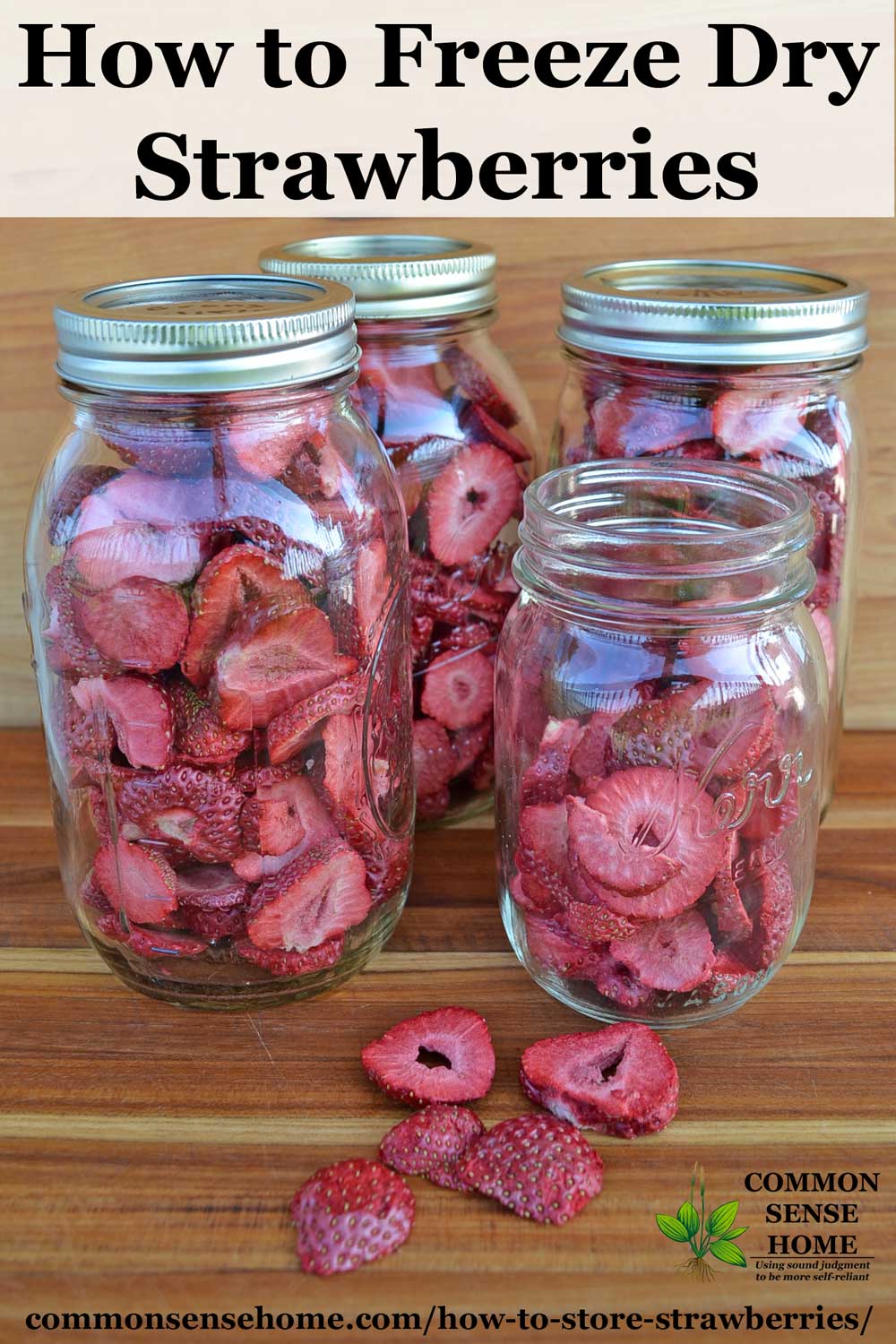
To freeze dry strawberries, clean and slice berries as you would for dehydrating. Place in a single layer on freeze dryer trays. Process in freeze dryer until completely dry (there should be no cold spots in the center of the berries).
Store freeze dried strawberries in a vacuum sealed mason jar or Mylar pouch with oxygen absorbers.
Click Here to Learn more about Harvest Right Home Freeze Dryers or Order Yours Now
You can watch the video below to see the whole process.
5 Homemade Strawberry Jam Recipes
Strawberry jam is many people’s favorite way to store strawberries, and over the years I’ve tried several variations. They include:
- Low Sugar Strawberry Jam – Sweetened With Sugar or Honey
- Strawberry Banana Jam
- Rhuberry Spread – Naturally Sweetened Strawberry-Rhubarb Jam
- Strawberry-Rhubarb Jam
- Strawberry-Banana Jam
Fermented Strawberry Storage – Strawberry Wine and Mead
For those who enjoy something a little stronger than kombucha, my friend, Colleen shares her recipe for strawberry mead (or melomel) at Attainable Sustainable.
I share my first round of strawberry wine making in the post, “Easy Strawberry Wine Recipe – Perfect for Beginners“.
You may also enjoy:
Remember, if you enjoy the post, please share on your favorite social media site. 🙂
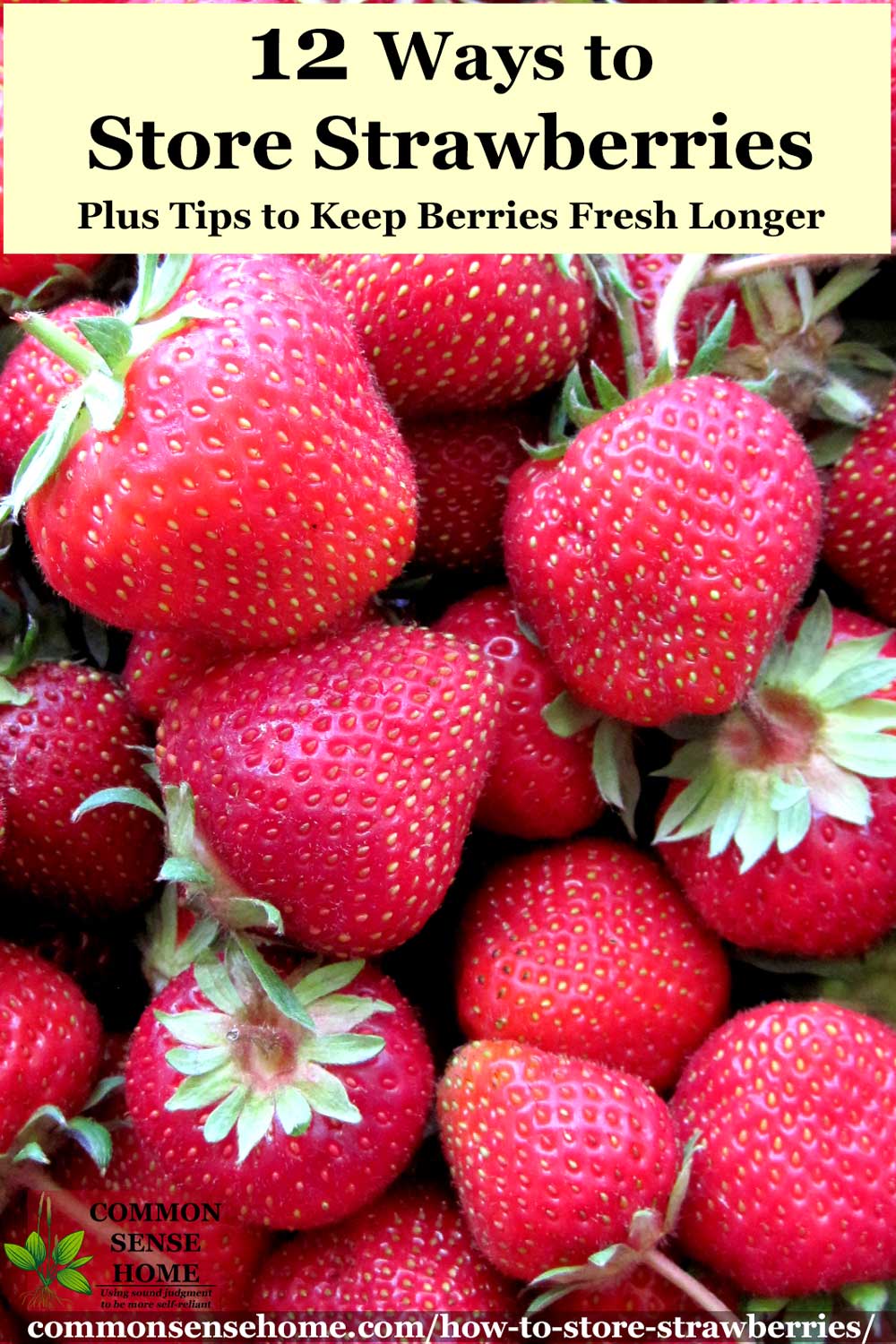
Originally published in 2011, updated 2016, 2018.



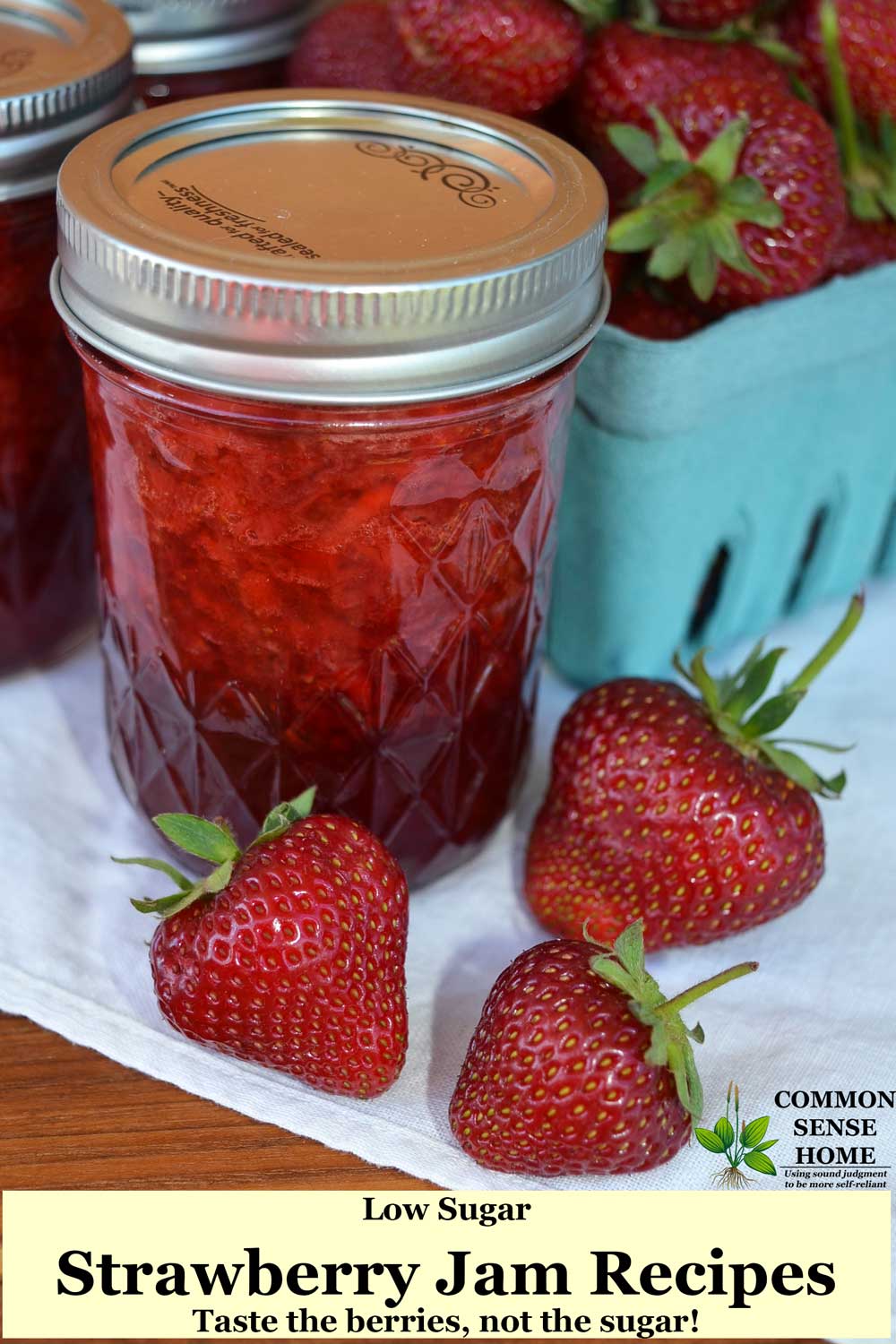

I think you are watching my kitchen! I just loaded my latest batch of blueberry, strawberry and raspberry juice into the freezer to prefreeze before the freeze dryer gets it. I love having the powder to add to all sorts of things especially homemade yogurt. I am definitely going to try the strawberry whipped cream you mentioned, that sounds delicious!
It’s so nice to add that pop of flavor without anything artificial, plus you can use the powder where the whole berries would make recipes too soft.
Morning Laurie.
I’m overwhelmed but can’t wait to get started. I just started canning (slowly) two years ago. Your strawberry recipes and tips are very exciting! I can’t wait for the warmer season and the strawberries and the other berries to come around, so I can start my canning and doing these other recipes. Thank you for posting them.
Morning Jayne, and you’re welcome.
I’m hoping we didn’t lose some of local strawberry crop to frost last night. I know there was frost not far north of us, and the berries are blooming. It’s been an interesting growing season so far.
I like the idea of using the strawberry hull in fruit leather. I have noticed, however, that the hull tends to hold a few bits of soil or mulch underneath even with a pretty thorough wash. I grow 3 varieties of strawberries on raised beds mulched with straw and have never formally analyzed whether one variety hides more than another. I don’t have running water, but instead rinse my strawberries briefly with filtered water, then give them an ozone bath (kills taces of mold spores or possible parasites) which jets a vigorous but gentle stream of tiny oxygen bubbles into a 3 or 4 inch filtered water bath. The berries tumble around in the jet for a few minutes, then I drain and hull them. Letting them blot themselves dry on towels sounds like a good idea. I have been hulling them, and that is when I noticed the little bits of dark mater and sometimes tiny scars. Depending on the volume of harvest. I may have to hold batches of berries for 2 or 3 days to get enough to process. Is this something you have noticed with U-Pick farmed strawberries, or is it one of those things that won’t have much impact? In our household, dehydrated strawberries are an excellent remedy for preventing colds. One slice from a good batch of under the tongue will clear the start of a sore throat or sniffle. All hail home grown bioflavinoids!
Sure, there are bits of flotsam stuck under the stems, even with you-pick strawberries, especially when the patch has sandy soil and there’s been some heavy rain. Different varieties will trap more or less, depending on how the stem sits. Some have stems that nestle against the fruit, others have stems that are lifted up and away from the fruit. I figure a tiny amount of soil is probably the least of my worries when it comes to eating strawberries, far behind the typical list of chemicals they are bathed in.
Sandy – what type of ozone generator do you have? We had an interesting occurrence on Monday. We were at the holistic dentist – me for my first session of amalgam removals, and my son for a cleaning. When my son got his ozone treatment, it cleared his sinuses, which have been stuffy due to allergies. It was amazing.
We use a rather basic ozone generator. It puts out a pretty high volume of ozone that is detectable near the water bath and to an extent in the air around the area. Ozone when released into the air will break down pollen and mold spores It can be irritating in high concentrations to sensitive tissue like nasal passages if used beyond a pretty low volume. We have used ionizing air filters to clear the air of allergens. Our favorite one was a Prozone, which used a small, ozone generating ultra-violet light in a vented casing with a high efficiency (computer type) muffin fan to blow air at high volume through the casing and rapidly move the ozone it generated into the air. It was intended for a small room for use about 15 minutes at a time a few times a day. These are still available for about $75 each if you buy a two or three at a time. Unless bolted into place overhead, they tend to fall and break easily.
The use of ionizing filters came under criticism a few years ago because of the powerful oxidizing effect. Too many people forgot to turn off units intended for a few minutes of use. At high concentrations, they will vulcanize rubber, deteriorate certain plastics and dissolve living tissue. You guys are great at research and I would recommend a thorough understanding of the benefits and limitations of ozonation before you invest in equipment. The one I use in the kitchen, an A2Z Ozone Aqua-6 uses a timer and is recommended for a brief, effective chemical detox and cleaning of vegetables. It can also be used for a foot or hand bath.
Air is forced through a permeable stone ball, which ionizes the air resulting in the bond between 2 oxygen molecules break, making them strongly attractive to other chemicals present in the vicinity. We keep one stone for veggies and one for therapeutic purposes. Some people have used low concentrations of ozonated water for internal cleansing, but too high a concentrations can be very irritating to mucous membranes, so skilled guidance is recommended. This article written by a long-tome proponent of holistic therapies, might be a good start to undersanading the properties and benefits of ozone https://rense.com/health/ozone.htm.
Ooooh, love the article, Laurie???? but would absolutely love to know what type of ozone generator you’re using, Sandy? and the cost.
I’m desperate for one of these for several reasons but the main one has to be to reduce the amount of water i’m using to clean fruit/veg. I have such an issue with making sure things are ‘clean’ but I kick myself for the amount of water I use ????
Dorinda, I recommend that you look through the reply I just (belatedly) made to Laurie. It includes details that might address your situation. Regarding water conservation, I can highly recommend the A2Z Ozone Aqu-6 we have in our kitchen. We pump all of our water by hand. It is very high in minerals, so I also filter it with a Berkey carbon filter gravity system. The berries are gently but thoroughly rinsed in filtered water, then I ozonate using filtered water. I have never measured how much I use, but would guess that a pint of berries takes a total of 2 quarts of water to rinse and ozonate. I have read that average households in the US that have water pressure use about 15 gallons per person per day. My husband and I use about 5 gallons of water per day, and in food processing season about 10 gallons a day. I am sensitive to both mold and common agricultural chemicals and am really satisfied with the ozone treatment for dehydrating produce.
That’s great, thanks Sandy. This was one of the ones I had looked at whilst researching, I’ve looked at so many so it’s nice to have someone confirm they use one and are happy with the results, especially as i’m In Europe so will be getting it mailed here.
Thanks again ????
Hi Laurie, Thanks for your lovely article on preserving strawberries. You have touched on all options available at home. I wished to ask if it is possible to leave the vacum packed strawberries at room temperature for some time, in case refrigeration facilities are not available. I am looking at a shelf life of 10-15 days. Do you think that they would remain usable for that period.
It really depends on the berries. The higher the water content and the riper the berries, the shorter their shelf life tends to be (but the better their flavor). Even with refrigeration, 10-15 day is a long time for berries. There’s no harm in trying to hold berries longer in a vacuum sealed container, but I suspect that without refrigeration, you’d be lucky if they lasted more than a few days.
A method using vacuum sealer is the best for me, cause I love fresh strawberries so it will be great when I keep it in freezer bags. Thanks for your post!
How do you store fruit leathers? How long will they last before going bad? Is there a way to store them for a longer shelf life?
Sometimes I store them in the fridge in a mason jar or ziplock baggie, sometimes I just store them in the pantry in a mason jar. If they are well dried, they don’t require refrigeration, and I’ve had them last over a year – but they usually get eaten long before then. (I found a jar that had gotten stuffed to the back of the pantry.)
I cut the leather into what I consider a serving – say 1/4 sheet from my “Nessie’ (NESCO) dehydrator – and lay the leather on a piece of plastic wrap with a bit of excess wrap all around the leather. Roll them up. This way the leather is well protected by the plastic wrap. Then for longer term storage I vacuum pack them – without the plastic wrap the leathers would become just a lump – and for really long term I put an oxygen absorbing packet (Amazon) in the vacuum bag. If the leathers are well dried this would keep them ‘fresh’ for years. Ha, ha, ha. Around here, only an accidentally hidden package would ever last that long!
Hi again!!
regarding the tops…..everytime I read about this it says the leaves, and it always says wild strawberry. It doesn’t matter if they are wild does it?
And also…. they are saying the leaves all the time…do they mean the tops or the leaves from the plant itself?
Your help/input would be a great help.
Thanks,
Helen
🙂
Helen, since wild and tame strawberries are related, I would think the properties would be similar. Livestrong is pretty reliable site and they don’t use the term “wild” – http://www.livestrong.com/article/472453-what-are-the-health-benefits-of-strawberry-leaves/
I believe the benefits can be found in all the foliage, leaves and stems alike, although obviously I’d only use greens from untreated plants.
Thank you!!
It was a little confusing seeing pics of just the tops all the time, but they always say the leaves of the plant!
I’ll get it yet 😉
I figure unless I see otherwise, green and leafy parts of a plant should have similar compounds. Stems and roots tend to be different, because the plant needs them for different things.
Julie – I have "painted" my kitchen several times with highly fermented beverages. 🙂
Yes I had that happen 2 weeks ago with my kefir water soda while we were at church. Now I keep the bottle "brewing" in a plastic bucket with lid 🙂
Thank you for your kind words, Debi. I have a lot of books on canning and preserving, but most don't have too many pictures, and I'm a visual person. I'm glad you enjoyed the post.
I always go back to you for help. I love all your information. Its a wonderful help for me. Debi
Thanks! The grain was divided between 20 families. I coordinated the order and it was delivered and sorted, etc., here. Only a couple of hundred pounds were mine. 🙂
Nice work with all of those berries! Did you order that much grain just for your family?! OR was this a bulk order split among friend? Looking forward to hearing more on that subject. I can't even imagine where I'd store a tenth of that. I already have buckets of wheat lining the wall of my closet.